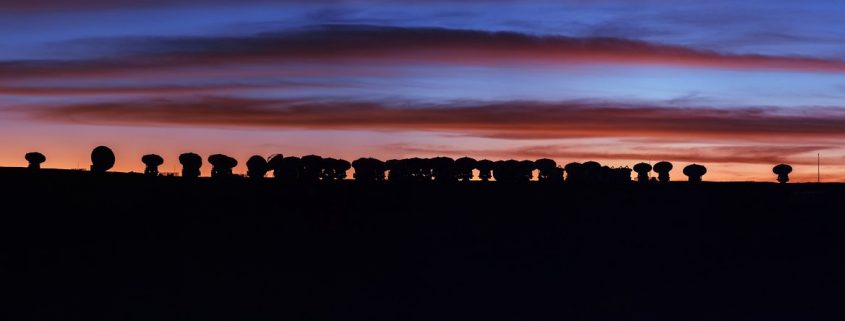The end of ALMA Cycle 7 and start of Cycle 8 2021 science observations
After a one-year break due to the Covid-19 pandemic, ALMA Cycle 7 science observations resumed on March 17, 2021, on a best-effort basis using 30-some antennas on the 12-m Array while the Array recovery was ongoing. Science observations with the Morita Array (ACA) restarted on May 18, 2021, using eight antennas. While some delays were encountered in the antenna configuration schedule due to bad weather and the pandemic affecting the maximum staffing levels at the site, the 12-m Array was successfully relocated to a hybrid configuration 9/10 by September, enabling the highest angular resolution observations in Cycle 7. The Array then moved back to configuration 8 by the start of Cycle 8 2021, facilitating a smooth transition to the start of the new cycle on October 1st.
With the start of Cycle 8 2021, 253 high-priority programs (Grades A & B) were added to the queue. The Cycle 8 call for proposals saw a total of 1735 proposals submitted requesting over 26,000 hours on the 12-m Array, exceeding the time requested in Cycle 7 by an extraordinary 37% and making this cycle the most competitive one to date. With the observatory encouraging larger, more ambitious programs, the number of proposals that requested between 25 and 50 hours roughly doubled and the number of Large Programs submitted increased to 40 in Cycle 8 from 14 in Cycle 7. Six Large Programs were selected to be carried out in Cycle 8, ranging in topics from exoplanets and the evolution of protoplanetary disks, the dynamics of the southern Bulge and central molecular zone of our galaxy, to nearby Jellyfish and ram pressure stripped galaxies and star-forming galaxies at z~4-5.
The ALMA Cycle 8 proposal call and review process was unique in many aspects. For the first time, proposals had to be written in a dual-anonymous fashion, hiding the identity of the proposal team from the reviewers, to reduce biases and make the review process as fair as possible. Of the 1735 proposals that were submitted, only nine had to be rejected because of not adhering to the guidelines. Furthermore, proposals requesting less than 25 hours on the 12-m Array or less than 150 hours on the Morita Array (ACA) were reviewed using a distributed peer review process. This meant the PIs were asked to review 10 proposals for every proposal submitted, with the option to delegate the review to a co-I. With this new system, more than one thousand astronomers reviewed a total of 1497 proposals. Moreover, dedicated review panels met virtually in the summer to discuss the proposals requesting between 25 and 50 hours on the 12-m Array and the Large Programs. Overall, the feedback on the newly-introduced dual-anonymous proposal review and distributed peer review have been overwhelmingly positive.
For a more detailed report on the outcome of the ALMA Cycle 8 2021 proposal review, see https://almascience.eso.org/news/documents-and-tools/cycle8/cycle8-2021-proposal-process


